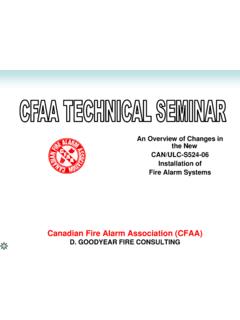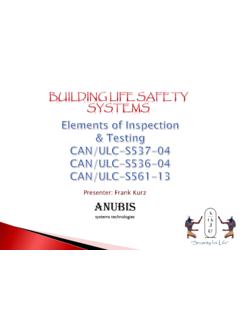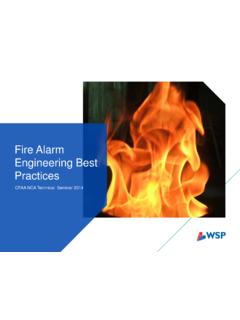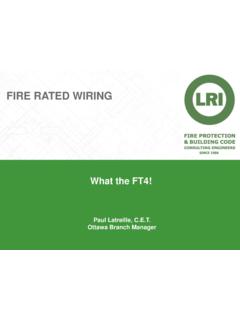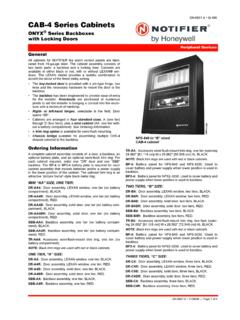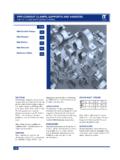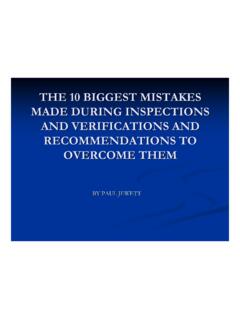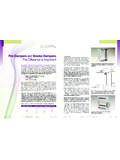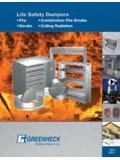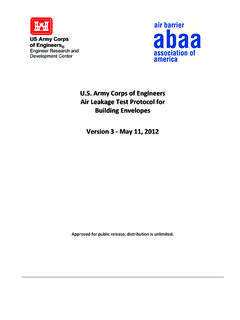Transcription of Smoke Control Design and Activation - Canadian …
1 CFAA NCA Technical Seminar 2015 Smoke Control Design and Activation Smoke Control Design and Activation 2 Overview Principles of Smoke Control Codes CACF controls Programming Commissioning Testing Goals To provide an introduction to Smoke Control To share best practices Format Open format. Questions and comments are welcome during the presentation. Smoke Control Design and Activation 3 Principles of Smoke Control Maintain tenability for occupant evacuation and firefighting activities -Occupant Evacuation .. shall be designed so that, during a period of 2 h after the start of a fire .. will not contain more than 1% by volume of contaminated air from the fire floor, assuming an outdoor temperature equal to the January Design temperature on a basis .. Contaminated air is taken to mean air with products of combustion The difference in temperature between the outside and inside of a building affects the pressure difference between contaminated air and clear air.
2 Affects the maximum height that a system can maintain both a minimum and maximum pressure difference across doorway boundaries. Smoke Control Design and Activation 4 Why is Smoke Control required in buildings? Smoke spreads quickly in a fire -Station Nightclub (2003) Recreation with sprinklers Recreation without sprinklers Smoke affects occupants remote from a fire -MGM Grand (1980) 68 of 85 deaths at levels 13 - 23 stories above the fire How are we doing with implementation? Not well understood Not well implemented Poorly maintained Smoke Control Design and Activation 5 How is Smoke Control implemented? Compartmentation Dilution Pressurization Buoyancy Airflow Compartmentation Design rooms and floor areas with a limited amount of leakage and the strength to withstand pressures developed in a fire .
3 Dilution Exhaust contaminated air and introduce fresh air into a space -Used for interconnected floor spaces -Used for venting by firefighters after extinguishment Smoke Control Design and Activation 6 How is Smoke Control implemented (cont.)? Dilution Example -How long would it take to reduce the concentration of contaminated air to 1% of its post fire concentration using a flow rate of 6 air changes per hour? = 1 ln 0 Where a = air changes per minute t = time in minutes Ct = concentration at time t C0 = initial concentration = 1660 minutes Smoke Control Design and Activation 7 How is Smoke Control implemented (cont.)? Pressurization Use fans to keep protected spaces and higher pressures than fire areas. Buoyancy Smoke shafts open to the exterior that depend on the buoyancy of Smoke .
4 Airflow Maintain minimum air flow speeds to overcome the buoyant forces developed by a fire and keep Smoke from spreading. Used in tunnels Smoke Control Design and Activation 8 Codes High Buildings [subsection ] -Stair pressurization -Elevator/Shaft protection -Zoned Smoke management - Smoke venting Interconnected Floor Areas [subsection ] Both prescriptive and performance options are available to designers Smoke Control Design and Activation 9 Code prescriptive requirements High Buildings [subsection ] OBC Supplementary Standard SB-4, NBCC Appendix B -Below grade stair pressurization [SB-4 & (2)] At the bottom with m3/s for each storey served by stair Vent at the top with m2 of vent area for each storey served by stair Vent area reduced by the number of doors open to stair.
5 -Above grade stair venting [ (3)] At the bottom to be opened manually and remain open m2 per door opening into the stair but not less than m2 in area Smoke Control Design and Activation 10 More code prescriptive requirements High Buildings [subsection ] OBC Supplementary Standard SB-4, NBCC Appendix B -Connected buildings [ (1)] Vented to outdoors or pressurized to maintain min DP 12 Pa -Venting to aid firefighting [ ] Windows, panels, dedicated Smoke shafts or the building HVAC system can be used Where HVAC system used, 6 air changes per hour from any floor to be maintained during venting operations (example previous slide) Where Smoke shaft is used, Smoke detector in shaft to operate opening to exterior at the top of the shaft. Smoke damper into shaft on fire floor controlled at CACF.
6 Smoke Control Design and Activation 11 Even more code prescriptive requirements Interconnected Floor Spaces [subsection ] - Smoke exhaust at 4 to 6 air changes per hour -Makeup air speed 1 m/s (4000 cfm/door) -Stair venting for lower buildings (18m+) -Stair vestibules vented or pressurized for higher buildings (75 m+) -Group B sleeping room vestibules pressurized -Zoned Smoke exhaust at 6 air changes per hour option Permits reduction in volume of Smoke exhaust in atrium Parking garage vestibule ventilation [ (4)] -Naturally with vent to the outdoors, with min area of , or -Mechanically with 14m3/h flow for each m2 of vestibule floor area Smoke protected seating areas [ (14)] Vertically separated buildings [ (6) SB-4 Measure K] -For unsprinklered buildings -Vestibules for firefighters elevators -Areas of refuge Smoke Control Design and Activation 12 Code performance options Zoned Smoke Control -Pressurize non- fire floors (either all or just those adjacent) -Exhaust fire floor causing negative pressure and therefore, relative positive pressure on non- fire floors Stair pressurization instead of venting -Pressure modulation using barometric dampers, or variable flow fans Smoke layer height management -For large volume spaces like arenas -Maintain Smoke layer height above the highest level of occupants not protected from Smoke .
7 Smoke Control Design and Activation 13 Equipment for Smoke Control - fire alarm controls Smoke Control Design and Activation 14 Equipment for Smoke Control -ULC listed for Smoke Control [category UUKLC]. -Testing criteria are ULC-S527, Control Units for fire Alarm Systems , and ULC/ORD-C100-13, Smoke Control System Equipment . Supervision of inputs and outputs Confirmation of operation Smoke Control Design and Activation 15 Equipment for Smoke Control Is one better than the other? - fire alarm for simple on/off controls -Automation equipment for everything else -Example HVAC used for venting to aid firefighting Smoke Control Design and Activation 16 Programming for Smoke Control Specifications Control Matrix (don t forget the manual controls) Don t wait until installation to test the matrix ADDRESSELEV RECALL ALARM & Smoke Control OPERATIONM3-32 PRIMARY C10W1 G10 ELEVATOR RECALL RELAYM6-3 PRIMARY C10WB J8 ELEV MACH.
8 RM - RECALLM3-92 RELAY C10W1 ELEVATOR MACH. ROOMM6-6 RELAY C10WB J9 ELEV MACH. ROOMM1-97 RELAY C10E1 B19 Control GND EAST NORTH SMK EXHM7-54 RELAY C10E1 C16 GND EAST NORTH SMK EXH#15M1-96 RELAY C10E1 E23 GND EAST SOUTH SMK EXH#19 ONM1-98 RELAY C10E1 D19 Control GND EAST SOUTH SMK EXHM5-101 RELAY C10WP J4 Smoke EXHAUST EF-20 START-UPM8-55 RELAY C10W1 G5 LIEBERT SHUTDOWN M3-45 RELAY C10W1 K5 AC UNITS SOUTH SIDE FAN S/DOWNM3-46 RELAY C10W1 M5 EXHAUST SOUTH SIDE START-UPM3-80 RELAY C10W1 H5 RM 1079 NORTH HI TEMP DC S/DOWNM3-81 RELAY C10W1 H5 RM 1079 SOUTH HI TEMP DC S/DOWNM2-79 RELAY C10EP D16 A03-AHU01,A03-RAF01 SHUTDOWNM2-91 RELAY C10EP D20 A03-RAF01.
9 A03-AHU02 SHUTDOWNM5-77 RELAY C10WP K5 A01-RAF01,A01-AHU01 SHUT DOWNM5-81 RELAY C10WP K8 A01-RAF02,A01-AHU02 SHUTDOWNSYSTEM RESETOFFOFFOFFOFFOFFOFFOFFOFFOFFOFFOFFOF FOFFOFFOFFOFFOFFOFFL18 GENERAL fire ALARML18 ACTIVEACTIVEM3-31 C10W1 G10 RM SMOKEM3-31 ACTIVEM6-2 C10WB J8 ELEV MACH. RM SMOKEM6-2 ACTIVELAB 10 EAST NORTH MANUAL Smoke EXH SWITH12-83 UP/DOWNON/OFFON/OFF` LAB 10 PULL STATION EAST NORTHM1-80 ,M7-20 ,M7-36 ONONANY TWO fire IN LIST144L144 ONONLAB 10 EAST SOUTH MANUAL Smoke EXH SWITH12-84 UP/DOWNON/OFFON/OFFLAB 10 PULL STATION EAST SOUTH M1-70,M1-26 ONONANY TWO fire IN LIST145 L145 ONONLAB 10 WEST NORTH MANUAL Smoke EXH SWITH12-81 UP/DOWNON/OFFON/OFF LAB 10 PULL STATION WEST NORTHM3-65 ,M8-56, M8-57 ,M8-63 ONONANY TWO fire IN LIST146 WEST NORTHL146 ONONACTIVE LAB 10 WEST SOUTH MANUAL Smoke EXH SWITH12-82 UP/DOWNON/OFFON/OFF LAB 10 PULL STATION WEST SOUTH M3-49 M3-67 ONONANY TWO fire IN LIST147 WEST SOUTH L147 ONONACTIVEM2-81 C10EP C16 DUCT Smoke A03-RAF01M2-81 ACTIVEM2-89 C10EP C20 DUCT Smoke A03-RAF01M2-89 ACTIVEM5-76 C10WP J4 A01-AHU01 DUCT SMOKEM5-76 ACTIVEM5-80 C10WP J8 A01-AHU02 DUCT SMOKEM5-80 ACTIVEAHU SHUTDOWNDC SHUTSMOKE EXHAUSTS moke Control Design and Activation 17 Commissioning for Smoke Control Integration with other systems to be commissioned together [ ]
10 CAN/ULC S1001-11, Standard for Integrated Systems Testing of fire Protection and Life Safety Systems Location Fan # Point # Occupied Operation Operation During Alarm Supply Return Supply Rtrn. Supply Return West 1st Floor 22 22 M1-1 On On Shut down West - Mezzanine 23 n/a M1-36 On On Shut down West - 2nd Floor 24 24 M1-57 On On Off Shut Down West 3rd Floor 25 25 M1-91 On On Shut Down On West 11th Floor 33 33-1 M4-61 Off On West 12th Floor Smoke Evac. * 33 33-2 On Shut Down of both fans, supply should have remained operational West 12th Floor 34 34 M5-1 On Shut Down both fans West - Penthouse 52 M5-61 Off Started West - Penthouse 50, 51 M5-62 Off Started x 2 Smoke Control Design and Activation 18 Commissioning for Smoke Control Integration with other systems to be commissioned together [ ] CAN/ULC S1001-11, Standard for Integrated Systems Testing of fire Protection and Life Safety Systems Smoke Control Design and Activation 19 Testing for Smoke Control NBC and OBC [ ], NFC and OFC [Part 7]

